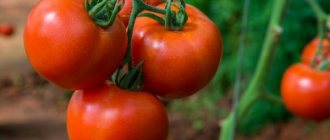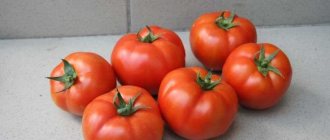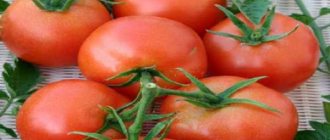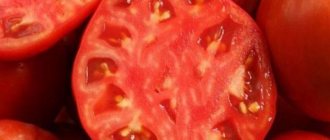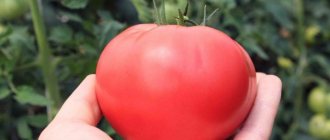| Ripening period: | early ripening |
| Shape, weight of fruits: | flat-round, weigh 80-150 grams |
| Bush type: | determinant |
| Growing regions: | Southern, Central, Northern |
| Productivity: | 12 kg per sq. m. |
The activities of breeders do not stand still and every year gardeners receive a large number of interesting new products. The Labrador tomato is no exception; the variety appeared relatively recently and has not yet been recorded in the State Register. Despite this, many farmers have already tried the described tomatoes on their own plots. Due to a number of positive qualities, Labrador has gained recognition in rural economies of the Southern, Central, and Northern regions.
Description of the Labrador tomato variety
Labrador tomato variety of non-hybrid origin. Belongs to plants of determinant type. Tomato bushes are short - about half a meter (a little higher in greenhouses), spreading. The stems are strong, fleshy, branched and sparsely leafy. The leaf frame is green in color, with variations in shade.
The inflorescences of the Labrador tomato are grouped into ordinary clusters: the first is tied above the seventh leaf, followed by distribution through the leaf. This variety of tomatoes does not need pinching, since it independently controls its own growth - it grows. Labrador tomatoes are endowed with high vitality, which is influenced by a well-developed root system.
Description of fruits
The fruits of Labrador tomatoes are round in shape, without sharp deformations or changes on the surface. Externally, tomatoes look like apples. About 13-15 tomatoes ripen on one bush, each weighing 80-90 g. There are giant tomatoes weighing up to 120-130 g.
Attention! The fruits of the Labrador variety do not crack and stay firmly on the bush after reaching full maturity.
The skin of the tomato is thin and cannot be felt when eaten. The pulp is juicy, fleshy, with a minimum of chambers and seeds, and has a sour-saccharine taste. At the stage of consumer ripeness, tomatoes are rich scarlet in color.
Plant care
Watering
Tomatoes need to be watered regularly
Irrigation technology is standard, frequency – several times a week. There is no need to flood the garden bed; tomatoes absorb moisture well without it.
As you know, tomatoes consist of more than 80% water, and Labradorite - 90%, because it is very juicy.
Top dressing
The following complexes are perfect as fertilizers: Red Giant, BioMaster, etc. Organic tinctures will not work here, as will solutions supersaturated with nitrogen and potassium.
To make a bush, select 3-4 of the strongest lateral branches, remove the remaining stepsons.
For best results, choose a proven, quality fertilizer: Gardener's Delight, Money Maker or Sweet Olive.
():
These types of fertilizers are not used in Russia. Our main fertilizers are Kemira, Fertika, Nitrophoska, etc.
Alternatively, when growing in hanging baskets, choose 'Cherry Cascade' or 'Tasty Tumbler'.
Tying up
The bushes are low, but they still need to be tied up, otherwise they will bend under the weight of the fruit.
Characteristics of tomato
The basic characteristics of the Labrador tomato variety include:
- possibility of cultivation in any region, regardless of climatic factors;
- early ripening compared to other varieties of tomatoes;
- consistently high yield, regardless of the place of cultivation;
- large and tasty fruits, with a thin shell;
- high resistance to diseases.
Productivity and fruiting
The Labrador tomato variety ripens early. From the first shoots to the removal of ripe fruits, it takes from 79 to 105 days, which depends on the climatic zone of growth and the planting location (greenhouse or street). Labrador tomato plantations produce equally good harvests, regardless of the type of growth - in protected or unprotected soil. When seedlings are planted in a greenhouse, ripening occurs in early June.
Up to 3 kg of vegetables are harvested from one bush, and 12-13 kg per square meter. Productivity is always stable, regardless of weather factors: tomato growth is not adversely affected by temperature fluctuations. Caring for Labrador tomatoes is simple, since there is no particular need for pinching and fixing to supports.
Recommendations! Some vegetable growers still resort to staking, since the bushes can break under the weight of the tomatoes.
Area of application of fruits
Labrador tomatoes are consumed mainly fresh and canned: juices, lecho, salads, adjika. It is not recommended to roll tomatoes whole into large jars, as the thin skin will burst under the influence of heat. When freshly picked, tomatoes do not last long.
Resistance to diseases and pests
Labrador tomatoes have strong immunity, so they are rarely affected by viruses and fungi, which often affect other varieties of nightshades. Due to early ripening, the variety does not have time to encounter late blight - the main enemy of vegetable crops of later fruiting periods.
Advantages and disadvantages of the variety
Like all plants, Labrador tomatoes have a number of advantages and disadvantages. The first include:
- consistently high productivity;
- unpretentiousness to care and growth conditions;
- simultaneous early filling;
- high resistance to diseases.
Among the disadvantages of the variety, one can note its short shelf life after harvest.
Agricultural technology
For planting and growing Labrador tomatoes, agricultural technology for early ripening varieties is used. Only a few nuances differ, which we will consider below. Preparations begin in the fall: the area where our bushes will be planted is selected.
Important! The site is prepared in a place protected from strong winds and well fertilized. It is recommended to apply fertilizers at the rate of:
- manure no more than 5-10 kg per 1 sq. m;
- organic and mineral fertilizers per 1 sq. m containing: 10-15 g urea, 40-50 g superphosphate, 20-25 g potassium salt or potassium magnesium.
Preparing seeds, planting seeds in boxes and caring for them
For more northern regions, seeds of early ripening tomatoes are recommended to be planted in boxes for seedlings.
If the seeds were purchased in specialized stores, then there is no need to treat them, but if they were collected from the previous harvest, then it would not be amiss to treat them with an antifungal agent and a weak solution of potassium permanganate.
After disinfection, the seeds must be washed.
Important! Sow the seeds
«Labrador
"
It is necessary 2 weeks earlier than other tomatoes.
The boxes are filled with an earthen mixture: garden soil, peat, sand, dolomite flour or sifted wood ash, humus or sifted compost.
The mixture for seedlings is poured over with boiling water, furrows are made at a distance of 3-4 cm and the seeds are planted no more than every 1 cm, to a depth of 1.5 cm. After planting, the boxes are covered with film and left in a warm place for the seeds to germinate.
When the first leaves appear, the film is removed and the boxes are moved to a cool, well-lit place. Seedlings are grown for up to 55-65 days. Watering is carried out regularly, approximately once a week.
Learn about growing tomatoes using the Maslov method, hydroponically, using the Terekhins method, on the windowsill and balcony.
Seedlings and planting in the ground
In early May, when the soil warms up to +15...+18 °C, seedlings are planted.
Seedlings are planted in open ground, maintaining a row spacing of up to 70 cm, and each row is formed 30-35 cm. The bushes must first be watered, freed from containers and planted in the ground until the first leaves.
If the seedlings have outgrown, they are planted at an angle so that the height above the ground is no more than 20-25 cm. After planting, the tomatoes are watered and covered with soil.
Care and watering
Since there is still a risk of frost when planting seedlings in open ground, it is necessary to provide methods of protection:
- covering the bushes with cut plastic bottles or glass jars (for small areas);
- smoke for large fields;
- watering is normalized.
Did you know? The sweetest tomatoes grow with minimal water and maximum sun.
Watering is best carried out in furrows, and fill the watering areas with dry soil, and not by rain and not under the roots. The irrigation rate is 20-25 liters per 1 square. m, but not too often.
Loosening the soil if there is a lack of moisture is necessary, because tomatoes can absorb moisture from the soil air. If there is an excess of organic fertilizers during drought, tomatoes can burn.
There is no need to plant this tomato.
To prevent the bushes from falling under the weight of the fruit, they are tied up after hammering in stakes.
Tying prevents the bushes from bending to the ground, and also promotes better air circulation, which in turn reduces the risk of late blight. You can tie it by driving stakes near each bush or to a wire or crossbar stretched from above.
Pests and diseases
The Labrador tomato variety is resistant to most known diseases. Breeders position the variety as resistant to late blight, the most common disease.
But this does not guarantee the non-occurrence of other diseases associated with improper care or attack by pests.
With excessive use of nitrogen fertilizers, excessive, irregular or infrequent watering, diseases such as phomosis (brown rot of fruits), cladosporiosis (brown spot), cracking of fruits, and verticillium wilt can occur.
The fight against diseases is carried out with the help of proper care or treatment with special preparations. Late blight does not affect this tomato variety due to its early ripening.
Pests can become a big danger for this variety:
- scoop (you can use the drug “Strela”);
- slugs (fight them with ground hot pepper or use a solution of slaked lime);
- whitefly (the drug “Confidor” will help);
- mole cricket (preparations “Thunder” or “Thunderstorm” can help, also treated with infusion of hot pepper or vinegar solution);
- wireworm (the drug “Bazudin” will help);
- aphids (preparation “Zubr”).
Growing rules
A rich tomato harvest can only be harvested if the seedlings are properly planted and nurtured. Do not skimp on seed material - they take much more than the planned number of seedlings.
Planting seedlings
In order to harvest ripe tomatoes as early as possible, seedlings begin approximately 55-60 days before planting in open ground. The best period for sowing is the end of March - the beginning of April.
As a substrate, a ready-made (purchased) one is used, already fully enriched with all the necessary microelements. Or they prepare it themselves, mixing: garden soil, peat, river sand, humus, ash and dolomite flour. Pour the mixture into mobile boxes. For 2-3 days, pour plenty of boiling water with the addition of several crystals of potassium permanganate. This will serve as disinfection.
Untreated seed material is prepared accordingly by soaking:
- in a weakly concentrated manganese solution;
- in juice from aloe leaves;
- in Fitosporin.
After which the seeds are dried on paper towels. Simultaneous germination of tomatoes is observed if the seedlings are additionally treated with any growth stimulant.
They dig grooves at a distance of 2.5-3 cm. Sowing is carried out to a depth of 1.5 cm, with an indent of 1 cm. Cover the top with glass or stretch a film. Place the crops in a warm place with plenty of light. With the first shoots, the shelter is removed. Water the Labrador tomato seedlings as the top soil layer dries out.
Picking begins as soon as 2 strong leaves are formed on the seedlings. Subsequent care for young tomatoes involves regular watering and shallow loosening. When the tomatoes are sufficiently elongated and strong, fertilizing with wood ash is allowed.
Tomato transplant
Tomato seedlings should be moved to a permanent place in the garden as soon as the soil warms up sufficiently (15-18 °C) and the threat of recurrent night frosts has passed. But before that, it is hardened, for which it is taken out into the fresh air every day. First for 15 minutes, gradually increasing the residence time (maximum 1.5-2 hours).
Advice! It is recommended to plant Labrador tomatoes in an area where peppers, eggplants, garlic, carrots, cabbage or cucumbers were previously grown. These representatives are not susceptible to late blight, which will prevent infection of tomatoes.
When planting tomatoes on unprotected ridges, you need to create a temporary shelter, which at first will protect weak seedlings from negative external influences.
Labrador tomatoes are planted in 2 rows in holes located at a distance of 40-45 cm. An interval of 60-65 cm is maintained between the rows. It is better to plant very elongated seedlings in a lying position, dropping drops to the lowest inflorescence.
Subsequent care for tomatoes
After planting the seedlings for the first time, the tomatoes are moistened for 3-4 days, after which mulch is laid out in the root zone. This technique will simplify the further care of tomatoes - there will be no need for systematic loosening and removal of weeds, since their growth is inhibited.
Important! Water the tomato plants between the rows, trying to prevent drops of water from falling on the foliage. It is unacceptable to irrigate bushes from above.
Labrador tomatoes are fed several times during the growing season:
- During planting: when digging the soil, add about 15 kg of humus or leaf compost, as well as up to 1.5 liters of wood ash (per 1 sq. m.).
- Fertilize tomatoes 2 times a month with Sudarushka and Universal mixtures. It is advisable to alternate the compositions.
- The bushes are pollinated with wood ash.
Fertilizing (external and root) with iodine solution has a positive effect on tomatoes. To speed up the fruiting process, spray with boric acid at the stage of formation of the first flowering cluster and with the appearance of the first tomatoes.
During this period, nitrogen-containing additives should be avoided, as they stimulate the growth of green mass to the detriment of fruiting.
Pollination process
In order for pollination of flowering and fruit set to occur much better, it is necessary to create greenhouse conditions and optimal temperature. During the day, the temperature should be 25 °C, but at night no more than 18. If the temperature is 33 °C, then the pollen becomes sterile and the flowers die instantly. But temperatures below 13 °C are a critical situation for pollen to form and fertilization itself. Also, the air should be fairly dry and the humidity should be 60%.
VID 20140806 102526
Tomatoes in open ground - End of the season
Yield varieties of TOMATOES: in seeds and in reality
If a draft is destructive for domestic flowers, then for tomatoes this is exactly what is needed. Thus, the air does not stand still and is constantly moving, and the percentage that the bushes can become infected with something is significantly reduced.
Disease and pest control
Despite their strong immunity, Labrador tomatoes can periodically get sick. This is mainly due to errors in agricultural care practices.
Excess nitrogen, excessive or insufficient watering causes some ailments:
- bursting of fruits;
- cladosporiosis;
- phomosis (rotting of tomatoes);
- sudden decline.
With systematic preventive measures, Labrador tomatoes grow healthy and produce a high-quality harvest.
Of the harmful insects that are especially dangerous for tomatoes:
- slugs;
- scoop;
- whitefly;
- mole cricket;
- wireworm
To combat them, systemic insecticides are used: Strela, Konfidor, Bazudin, Zubr, Grom, Groza. Folk remedies are also effective: pepper infusion, slaked lime. An effective countermeasure against parasitic infestations will be the timely removal of weeds.
Advantages
This variety is not afraid of any pests or diseases
. Even despite its short existence, the species has already established itself as a good type that can withstand various temperature changes and can cope with even the most severe diseases. Pros of Labrador:
- high percentage of yield;
- large fruits;
- excellent presentation;
- long shelf life;
- early ripeness.
Labrador tomatoes can resist all diseases and pests are not afraid of them, and even if they attack, it is enough to carry out preventive methods against them by treating the bushes with onion infusion or potassium permanganate.
Reviews
Inna:
“I love Labrador for its taste and excellent response to the use of black plastic, with which the tomatoes not only ripen faster, but also form in greater quantities. I haven’t found a better early-ripening tomato yet.”
Alexander:
“An amazing variety that is capable of producing a large harvest of fragrant fruits. The bushes are powerful, despite the fact that they are compact. Diseases did not bother the plant. In two years I have not yet seen any signs of serious illness on them. Bacterial spotting after rains does not count.”
Makar:
“A pleasant variety that can surprise with its resistance to various diseases. But I don’t risk growing tomatoes without periodically using a potassium permanganate solution. Extra protection never hurts."
Valeria:
“Tomatoes are not susceptible to serious diseases, but I had to fight insects more than once. The main thing is that we managed to save the harvest in the end.”
Maksim:
“Good tomatoes with an amazing pleasant taste. For me, the big advantage is ease of care and the possibility of dense planting compared to medium-sized and tall plants.”
Gardeners' opinion
Reviews about the Labrador tomato are positive. Only the process of gartering and styling raises questions and bewilderment. Otherwise, users are happy with everything.
Regarding care, everything is just as simple. The culture is less demanding of environmental conditions and can germinate and produce a good harvest even if it has not been properly cared for.
Genetics and germination conditions play a big role. Soil is the main factor. If it is chosen incorrectly, you will have to fertilize frequently, increase control and watering, and also conduct frequent diagnostics for diseases and pests.
